
Hurricane FAQ
Frequently Asked Questions
Community Resilience
Just because it spins - doesn't mean it's Tropical
Jump To:
Protect From Storm Surge
What is a...
Future
Future
Future

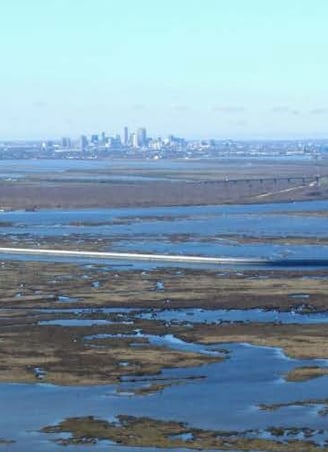
Protect from Storm Surge
Communities can become more resilient and less vulnerable to storm surge. This can come in many forms from preserving or restoring natural habitats, sand dunes, wetlands, building codes, man made barriers, moveable gates and other forms of stopping or buying time in surge events.
An example is the New Orleans region. After Hurricane Katrina (2005) multiple gates, locks, levees and barriers were erected in order to help buy time and control storm surge flooding. Additional information: https://www.floodauthority.org
IHNC Lake Borgne Surge Barrier, New Orleans in background, 2013, image by U.S. Army Corps of Engineers




Placeholder
While still a Low Pressure weather system (and therefore also referred to as a ‘Cyclone’), Tropical Cyclones (Hurricane, Cyclone, Typhoon) differ from other storm systems by drawing their energy from warm water heat energy, have a warm core, not part of a frontal system, originate over tropical or subtropical waters, have organized deep convection and a closed low level circulation. For a further breakdown of these factors see ‘Hurricane Formation Factors’ FAQ.
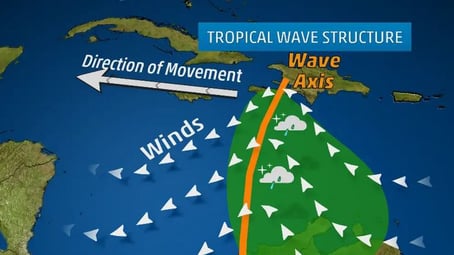

Placeholder
Elongated areas of Low Pressure, or a Trough, generally oriented in a North - South direction that move along within the trade winds. For the North Atlantic these mostly move in an East to West direction, typically seen between Northern Africa and into the Caribbean. Sometimes satellites can show a general upside down ‘V’ shape along this wave axis. In general there may be scattered showers and breezy conditions within but sometimes these eventually develop into and can be one source of a Tropical Cyclone. In the Atlantic around 60 or so are seen each year with the majority occurring in the June to August time period. These may be designated as ‘Invest’ if they begin to show, or modeling shows, more Tropical Cyclone development potential.
Example of the typical structure of a tropical wave moving through the Caribbean. (Image credit: The Weather Channel)
Sample map of what a tropical wave may be oriented or how it moves. (Image credit: NOAA)
NHC TAFB surface analysis map showing two tropical waves 17 May 2022. (Image credit: NHC/NOAA)
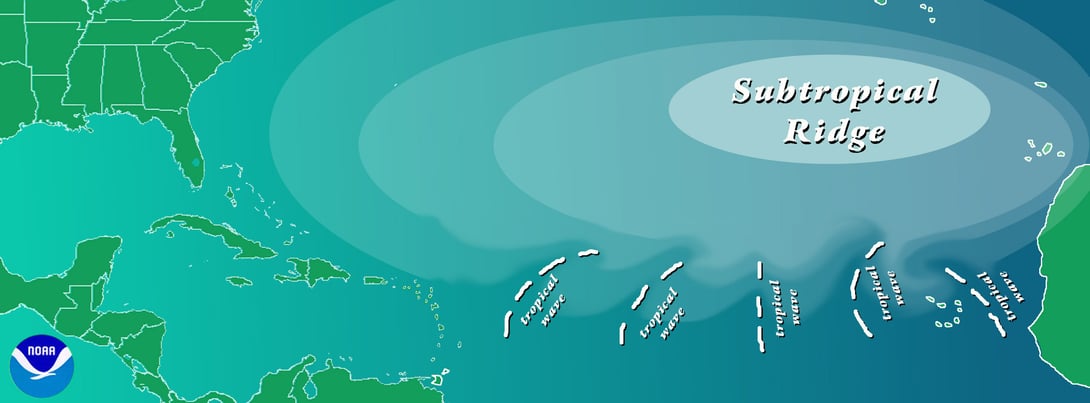

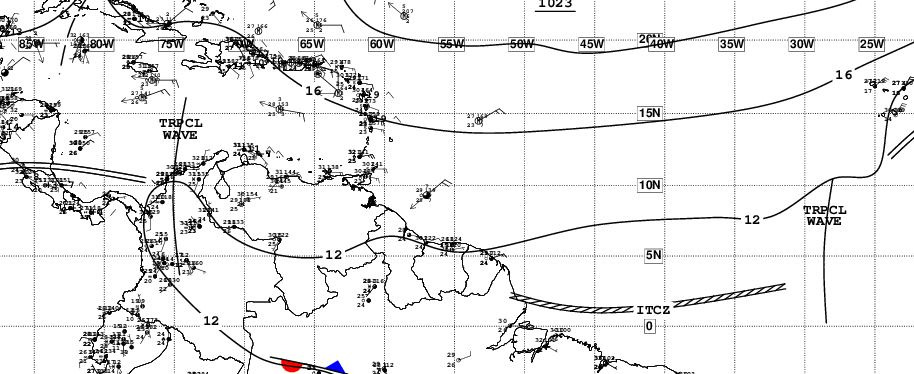



Placeholder
An Invest is an area of disorganized scattered showers and breezy conditions that has Tropical Cyclone development potential that has been officially designated as an area of interest, or investigative area.
An Invest may be a Tropical Wave, a Low Pressure system, or any area with Tropical Cyclone development or transition potential. Designation as an Invest allows academic and government agencies to task data collection & analysis activities of the area of interest. An Invest typically precedes the declaration of a Tropical Depression or named Tropical Storm which are stronger and more organized weather systems. Not every Invest develops into a Tropical Cyclone and not every Cyclone starts off classified as an Invest.
Invest are labeled around the globe by "##X" (Number Number Letter) format in order to monitor and communicate information about possible future development. The numbers and letters are specific to each basin (see list below). Each basin starts the season with number 90, increasing by 1 each area of interest in that basin until reaching 99, then repeats starting from 90 again (ie: 90, 91...98, 99, 90, 91, etc.). Be sure to check dates when viewing specific Invest information due to the repeating numbering system as Invest may only last a few days. Numbers in the 80's are typically reserved for testing. Following the number is a letter which represents which basin the area of interest is located in. Examples of Invest numbering: Invest 92L, Invest 90E, 98S etc.
Basin Letters:
A = Arabian Sea
B = Bay of Bengal
C = Central North Pacific
E = East North Pacific
L = North Atlantic (including Gulf of Mexico & Caribbean)
M = Mediterranean
P = South Pacific (including Australian region East of 135deg)
Q = South Atlantic
S = South Indian Ocean (including Australian region West of 135deg)
W = West North Pacific
In the North Atlantic, Central and East North Pacific an Invest may be declared a Potential Tropical Cyclone (PTC) if development is highly likely (See ‘What is a PTC (Potential Tropical Cyclone)?’ further below for additional details). When the US National Hurricane Center (NHC) is issuing regular or special Tropical Weather Outlooks (TWO), the formation chances of these invest are given, typically divided into three separate groups of 0-40%, 40-60% and 60+% chance (reference ‘What are the Two Day and Five Day Graphical Tropical Weather Outlooks(TWO)?’ for further information).
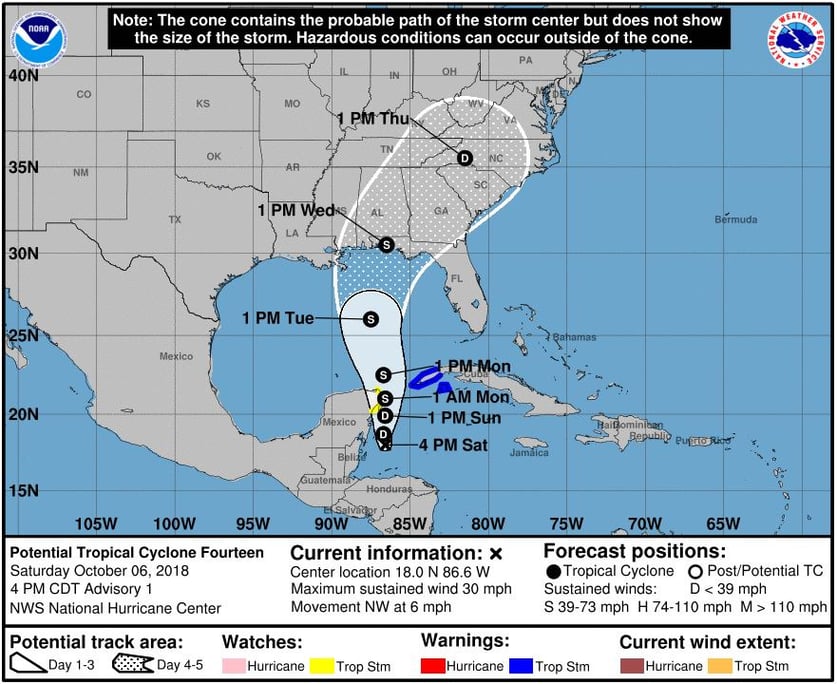

Placeholder
Potential Tropical Cyclones (PTC) were implemented by the US National Hurricane Center (NHC) starting in 2017. The purpose of a PTC is to give advanced lead time on communicating potential tropical cyclone hazards and other details prior to a storm actually developing or organizing enough to be classified as a tropical cyclone. PTC designation can be used for this purpose if Tropical Storm or Hurricane force winds are possible on land within 48 hours or less. This grants the NHC the ability to issue the full suite of tropical cyclone advisory products including five day cone map, wind probabilities, text advisories, storm surge information, Tropical Storm and Hurricane Watches and Warnings, etc. Prior to PTC’s the NHC did not publish these advisory products because of storm classification.
PTC’s are numbered the same way as Tropical Depressions or any other designated tropical cyclone for each calendar year by taking the next available number for that basin. If ‘Tropical Depression Two’ was the last storm advisories were issued on then the next system would be ‘Three’ whether it was declared a PTC, Tropical Depression or Storm. The next would be ‘Four’ and so on. Just like other tropical cyclone advisory products, the NHC updates PTC system information every six hours at 5 & 11am/pm EDT. When Tropical Storm or Hurricane Watch and Warnings are posted updates are added at 2 and 8am/pm EDT. PTC products are only issued by the NHC for the Central and Eastern North Pacific and North Atlantic basins.
PTC five day cone of uncertainty map for what would later become Cat5 Hurricane Michael 6 October 2018 before it formed. (Image credit: NHC/NOAA)


Placeholder
A Tropical Depression (TD) is a Tropical Cyclone (TC) with sustained winds of 38mph (61km/h, 33knots) or less, but can have higher wind gusts.
A Tropical Depression may cause a wide range of impacts or barely be noticed at all (Each storm is different). Tropical Depressions typically do not prompt evacuations and there are no ‘Tropical Depression Watch’ or ‘Warning’. These storms can still be deadly and cause damage including spawning tornadoes, inland flooding from excessive rainfall, scattered downed trees, scattered power outages, storm surge flooding, etc. It doesn't take a named Tropical Storm to cause major impacts.
While not named, a Tropical Depression is numbered starting at 'One' each calendar year, increasing in increments of one with each successive storm. The numbers are specific to each basin. Similar to Invest, some basins place a letter after the number to identify which basin such as the East North Pacific (E) and South Indian Ocean (S). While the Atlantic invest letter is ‘L’, it is typically left off (ie: ‘OneE’ (East North Pacific), ‘One’ (North Atlantic), ‘TwoW’ (West North Pacific), etc.). See ‘What is an Invest?’ above for a full basin letter list). If a storm becomes a named Tropical Storm the name takes precedence, but the storm still retains its original number and basin letter (ie: ‘01L’, ‘02E’, ‘02L’ etc.). If a storm more rapidly develops and is declared a named Tropical Storm instead of Depression it still has the next number that would have been given. Storms in the Northern Hemisphere spin counterclockwise while those South of the equator spin clockwise.
Note: WeatherSources uses the Saffir-Simpson scale 1-minute sustained wind speed average at 10m (33ft) for storm classification while other areas of the world outside of the North Atlantic or Central and East North Pacific may use other scales and/or timed wind speed averages for wind/storm classification.